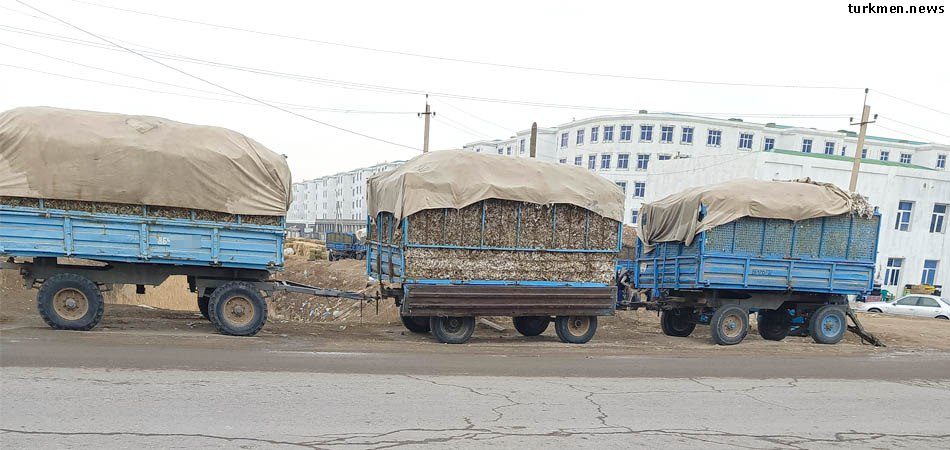
Turkmen Celebrity Arrested on Suspicion of Being Gay
16.04.2020
In many regions of Turkmenistan farmers are choosing not to deliver the residues from their cotton harvest to the state, but to sell them at greater profit to private livestock owners for feed. They are doing this because of the extremely low purchase prices for this type of cotton. The residues are raw cotton of very poor quality which has fallen between the rows after harvesting by machine or hand. More residues are left in the rows during machine harvest, especially if the picker’s doffing mechanism has not been set properly.

By selling the residues to private cattle owners, the farmers receive their money straightaway, moreover in cash, and far more than they would have received from the state, while livestock owners readily pay for nutritious fodder. Only the state loses out, as it fails to respond in any way to the pretty much poverty-stricken plight of farmers and does not want to reform the agro-industrial complex.
In Turkmenistan, land belongs to the state. It is the state that regulates the volumes of production of wheat, rice, and cotton, sets purchase prices, and supplies farmers with seeds, fertilizers, and equipment. Farmers’ associations cultivate the land according to tenancy agreements. The state is the sole legal purchaser of the harvest.
However, in Mary region cartloads of cotton can now be seen on the roadside on sale to allcomers. This is mainly residues, i.e. leftovers remaining in the fields after the combine has passed through. But there are also cartloads with almost pure, low-grade cotton. Such rich residues are collected from fields where the cotton picker was operated by an inexperienced driver.
This type of cart holds approximately two tons. The negotiated price ranges from 1,500 to 2,000 manats (up to $100) depending on whether it’s mostly cotton bolls or stalks. When the cotton residues in one such cart are cleaned at the procurement center or directly at the cotton processing plant, they make 150 to 200 kilograms of cotton for the tenant, i.e. the state, though the tenant farmer will receive just pennies for them.

This is why tenant farmers prefer to sell their raw cotton (where fibers have not yet been separated from the seeds) not to the state, but to private farmers as feed for livestock at a highly profitable price. The owners of private farmsteads don’t lose out on the residues either – after soaking in hot water the raw cotton turns into excellent fodder with a high content of protein and other nutrients. The intensive addition of this fodder to an animal’s diet means a bullock can be fattened for slaughter in two to three months.
The sale of cotton residues happens everywhere and is barely hidden. This may be because in January the plan is formally considered to have been met, although this has not been announced officially in recent years.
Aware that there will be high demand for animal fodder in winter, at the end of the harvest season many tenant farmers deliberately keep back the residues harvested from the fields. However, fearing problems with the local authorities, they do take precautions and try to keep things under wraps. For example, carts are moved from one place to another. Some farmers put their phone numbers on the carts, so buyers can order the feed when necessary.
According to sources, oversight of the cotton harvest “down to the last bolls” and of the ginning process and delivery of the cotton residues was much stricter in Soviet times. Even when the dry cotton plant stalks were used as fuel for tandoor ovens, people ensured that no white cotton lint remained on the stalks. Otherwise, an official might see them and cause serious trouble for “wasting state resources.”
Observers think it’s pointless to try and catch the traders. Instead, the state should raise the purchase prices which have not been increased for many years and review the overall approach to agriculture, giving the farmers more freedom and introducing market relations, which they talk about so much on television.

Upmarket Bar in Ashgabat Closed After Brawls Involving President’s Cousins
08.04.2024

Turkmenistan’s Defense Minister Deprived Officers From Housing Entitlement Despite Widespread Resignations
28.02.2024

Murder and Suicide at Troubled Turkmen School
28.02.2024

Turkmen Prosecutor’s Office Claims Baloch Detainee’s Fatal Wounds Were Self-Inflicted
01.02.2024

Young Man Tortured to Death by Law-Enforcement Officers in Turkmenistan (video)
21.12.2023
Tell us!
Add comment
your e-mail will not be published